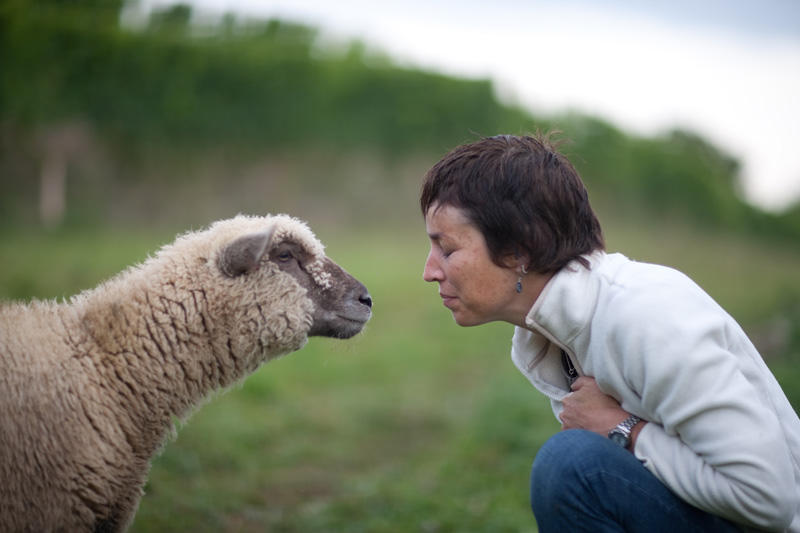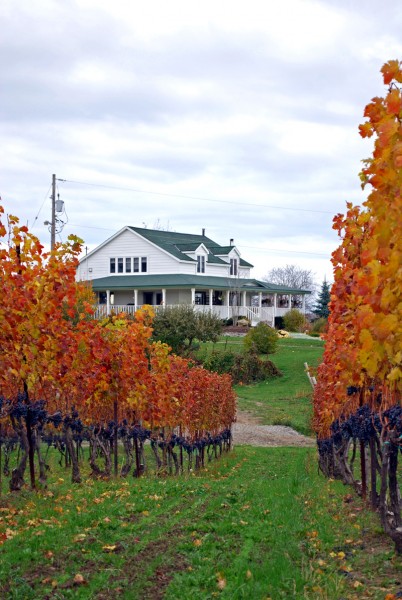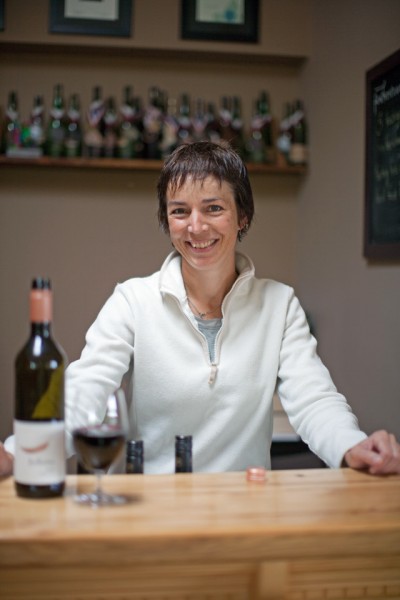
Louise Engel bubbles with pride. Her Featherstone Cuvée Joy 2011 sparkling wine just took top honours at a national wine competition, which is no small feat for the modest Niagara winery considering the competition it was up against.
Featherstone Cuvée Joy won Best Sparkling Wine of the Year and Double Gold at the All-Canadian Wine Championships. Not bad for a winery that only started crafting bubbles in 2008 and makes merely 169 cases of the wine.

“We really do enjoy playing with sparkles,” Engel, pictured above, tells me as we taste through the new releases. Success with the blanc de blancs has sparked a desire for a 100% Pinot Noir sparkling wine in the future.
Joy is made in the French style ‘methode traditionnelle’ from 100% estate Chardonnay. It sits on the less for three years and is sealed with a simple and easy crown cap.
Crafted by Engel’s husband and co-owner of Featherstone, David Johnson, the grapes are hand picked when they are slightly under-ripe, between 17.5 a nd 18 brix.
nd 18 brix.
A slow and steady fermentation without any oxidized or reductive result is imperative, explains Johnson. “What we look for at this step is not the aromatic character but an organoleptic balance,” he says.
A full, or partial malolactic fermentation might be started at this stage, depending on the initial balance and the desired aromatic range.
To prevent oxidation of the fermented base wine, a light sulphiting is done — being careful not to hinder the potential for future bottle fermentation.
Concern over any potential oxidation is of utmost importance to Johnson, stemming from the fact that the effervescence in sparkling wine will lift and carry any unpleasant aromas that are present.
The base wine is next clarified by fining and by filtration. Perfect stability is required to avoid any protein “ghosts” or tartaric precipitation (“wine diamonds”) within the bottle.
A “triage” is then prepared and added to the base wine as the wine is being bottled. The triage mix, which contains both sugar and yeast, is very important, says Johnson, because it leads to the secondary fermentation within the bottle, and this determines the exact pressure and percentage of alcohol in the finished sparkling wine.
 Johnson then allows the wine to rest in the bottle on the lees for 30 months, which gives it time to develop all of the desired features of the “methode traditionnelle” such as volume, smoothness and aromatic complexity.
Johnson then allows the wine to rest in the bottle on the lees for 30 months, which gives it time to develop all of the desired features of the “methode traditionnelle” such as volume, smoothness and aromatic complexity.
The disgorgement process involves dipping the neck of the bottle in liquid glycol to freeze the wad, or plug, of dead yeast cells. In an instantaneous process, the plug is frozen, the crown cap is removed from the bottle, the plug is blasted out by the bottle’s own pressure, dosage is added and the wine is re-sealed permanently. The final touch is the dosage. This is the stage where you can erase petty imperfections and also give personality to the wine, Johnson says. The exact blend that constitutes a winery’s dosage is always a secret that is carefully guarded. “At Featherstone our dosage is no less a secret, although I will divulge … that brandy from the birth year of the owners (Dave and Louise) is involved.”
By the way, Cuvée Joy is named after a woman at the heart of the family — Johnson’s mother, Joyce.
Here’s what I tasted and liked from the new releases, including the award-winning Cuvée Joy.

Featherstone Cuvée Joy 2011 ($35, winery, December release at Vintages, 92 points) — A traditionally-made sparkler made from 100% estate-grown Chardonnay. This such is a delightful, yes, joyful, wine with a nose of brisk lemon, baked apple, toast, citrus and interesting yeasty-bready notes. Perfect tiny bubbles tickle the palate with a lovely melange of citrus, toast and creamy notes all lifted by wonderful, refreshing acidity.

Featherstone Rose 2014 ($15, winery, Vintages, 87 points) — This is a blend of Merlot and Gamay with a nose of strawberry and wild raspberries. It’s delicious on the palate with red fruits, herbs and touch of sweetness.

Featherstone Sauvignon Blanc 2014 ($18, winery, Vintages June 27, 88 points) — A nose of fresh hay, tropical fruit, mango, lime and citrus. It turns to more opulent tropical fruit on the palate with touches of grass and herbs through the finish with refreshing acidity.
Featherstone Black Sheep Riesling 2014 ($17, winery, Vintages, 91 points) — Always a favourite Riesling of mine from Niagara. The aromas jump from the glass: Lime, apple, flint and a melange of citrus. On the palate this is all about the flinty minerality, citrus and a touch of apple. A firm bed of acidity makes this electric all the way through the finish. I tried this beside the 2013 version and can recommend that you throw a few of these Rieslings in the cellar for a year or two for even greater pleasure.
Featherstone Canadian Oak Chardonnay 2013 ($22, winery in a couple of weeks when the 2012 vintages runs out, Vintages Dec. 12, 90 points) — Doesn’t get anymore local than this signature wine from Featherstone. Estate Chardonnay, wild fermented (in oak barrels placed in the vineyard), with the oak coming from trees grown along the Grand River in Brantford. So, “our yeast, our grapes and our wood,” says Louise Engels. Thinking of a wine for Canada Day? This just might be it. The nose shows rich pear, grilled pineapple, butterscotch-vanilla and creamy buttery notes. It’s spicy and lush on the palate, but not as over-the-top as the original vintages of this wine were while Johnson was getting a feel for the grain of Canadian oak. There are notes of poached pear and baked apple with toasty spices and butterscotch with enough acidity to give this wine a fresh lift through the finish. Interesting and comforting Chard.
Featherstone Pinot Noir 2011 ($25, winery end of July, 89 points) — From low-yielding Pinot with more concentration than previous vintages, look for an expressive nose of earthy, rich, black cherry, raspberry, bramble, cinnamon and spice. It’s a bold offering on the palate, yet there is freshness, with cherry, cedar, leather and spice notes with plenty of finesse. Engel recommends serving this with fresh grilled salmon or roast pheasant.
Featherstone Red-Tail Merlot 2013 ($20, winery, Vintages Oct. 17, 88 points) — Fans of Featherstone Merlot may want to load up on the 2013 vintage; the ravages of two bad winters took a toll on the Merlot vines at the estate. What was left of the 2014 Merlot went to rose after about 35% of the vineyard was lost. Almost as much was lost in 2015 and it’s not looking like there will not be a Merlot made in that vintage. Featherstone is replanting but doesn’t know when there will be another vintage of the Red Tail. The nose shows pretty raspberry, cherry, cedar and spice. It’s a medium-bodied offering on the palate with rich red fruits, cran-cherry and spice with freshness through the finish.

Featherstone Cabernet Franc 2013 ($19, Vintages Essential, 89 points) — Textbook Niagara CF with a nose of cherry, herbs, pepper, cassis and spices. It’s bright and cheerful on the palate, a gorgeous food wine, with red fruits, garden herbs, chewy tannins, plums and spice.





Comment here